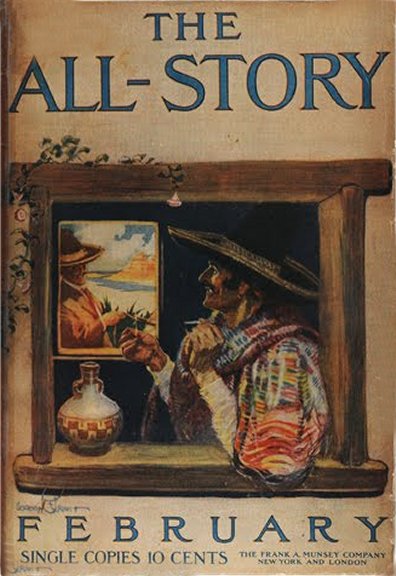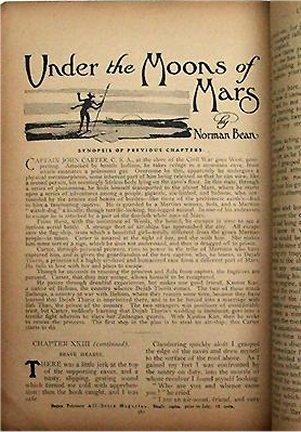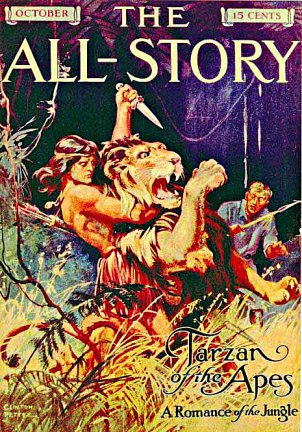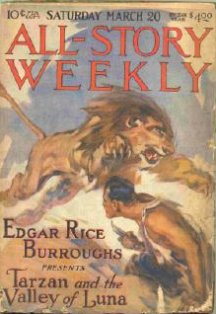The Story Behind the Original All-Story
by Frank M. Robinson

 At the
turn of the last century, there was no television, no movies, no comic
books, no paperbacks as we know them today. Some houses were wired for
electricity, but it was still the era of gaslight. Horses were more common
than automobiles, and in rural areas, outdoor plumbing was the norm. People
worked long hours and six-day weeks, and they had relatively little time
for entertainment. When they did, the most popular form was what you're
doing now: reading. It was the start of the golden age of magazines, and
"pulp"magazines, publications the size of today's National Geographic but
printed on cheap newsprint, became a large part of the boom.
At the
turn of the last century, there was no television, no movies, no comic
books, no paperbacks as we know them today. Some houses were wired for
electricity, but it was still the era of gaslight. Horses were more common
than automobiles, and in rural areas, outdoor plumbing was the norm. People
worked long hours and six-day weeks, and they had relatively little time
for entertainment. When they did, the most popular form was what you're
doing now: reading. It was the start of the golden age of magazines, and
"pulp"magazines, publications the size of today's National Geographic but
printed on cheap newsprint, became a large part of the boom.
Glossy magazines -- the "slicks" -- featured large
numbers of photographs and advertisements, which required a costly coated
paper stock. They were expensive to produce and, since advertising paid
the bills, they had to sell in the millions, most of them by subscription.
The pulps, in contrast, were cheap to produce, had
few ads and no photographs, were printed on inexpensive paper, and sold
most of their copies off the newsstands. At first, there was little difference
between the fiction that appeared in the pulps and the slicks; much of
it was by the same authors. If an author failed to place a story with The
Saturday Evening Post, it might find a home in one of the Post's poorer
cousins.
With time and competition, however,the pulps began
to feature more action stories, some of them wildly implausible -- a selling
point for the pulp audience. The slicks, on the other hand, were reality
bound. Their stories didn't stray far from home and hearth, while pulp
stories frequently ventured from the Wild West to darkest Africa, or voyaged
to the moon or Mars.
The sensational fiction in the pulps was complemented
by the flashy and arresting art on the magazines' covers, the images that
characterized the golden age of magazine illustration. Initially, many
of the artists whose work graced the covers of the slicks also illustrated
the covers of the pulps: N. C. Wyeth (father of Andrew), Joseph Leyendecker,
and Harvey Dunn, to name a few. Later, the pulps cultivated their own artists,whose
canvases are now auctioned for tens of thousands of dollars, and whose
work you can see reprinted in this issue of Zoetrope: All-Story.
The man who started the pulps was Frank A. Munsey,
a farmer's son who managed the Western Union office in Augusta, Maine,
and then decamped to New York City to find his fortune in publishing. His
initial attempt, a magazine for boys titled The Argosy, was on life support
for its first fourteen years. To keep it afloat, Munsey became a workaholic
who acted as editor, ad salesman, writer (he wrote much of the fiction
he published), and publicity agent, and probably swept out the office on
Saturdays.
Munsey finally struck it rich when he invented the
ten-cent magazine -- Munsey's, a slick -- a revelation in a country where
the average weekly wage was seven dollars, and most slick magazines cost
twenty-five cents. But Munsey's other magazine, The Argosy--which had become
a cheap imitation of the average slick, complete with essays, badly printed
photographs, and some fiction--didn't sell, even at ten cents. Desperate,
in 1896 Munsey turned it into an all-fiction magazine printed on low-grade
pulp paper, stripping it of the articles and most of the pictures.
Fiction, it turned out, was what the readers really
wanted. The magazine's circulation doubled and redoubled. With the profits
from Munsey's and The Argosy, Munsey chainsawed his way through the newspaper
jungles of New York, buying, killing, and combining papers with the ruthlessness
of an early Rupert Murdoch. When he died, he left most of his fortune of
$40 million to the Metropolitan Museum of Art, an institution that Munsey's
many enemies claimed he had never entered.
The Argosy had the all-fiction field to itself for
seven years before a successful competitor, The Popular Magazine, showed
up in 1903. Munsey reasoned that if there was room for two all-fiction
magazines, there might even be room for a third.
The first issue of The All-Story--the
magazine that inspired Zoetrope: All-Story's name--was published
in January 1905. The All-Story (later retitled All-Story Weekly)
ran until 1920, an all-fiction pulp-paper magazine that sold for the bargain
price of ten cents for 192 pages. All-Story was never the top seller
in its field, but a credible claim could be made that it was more creative
and had a more solid literary reputation than its competitors. Edward J.
O'Brien's annual collection of the Best Short Stories for 1918 reprinted
two from All-Story ("A Simple Act of Piety," by Achmed Abdullah,
and "The Gallowsmith," by Irwin S. Cobb). That same year, thirty-seven
other stories were given Honorable Mention, more than any other all-fiction
magazine in America (and by that time there were quite a few).
Most pulp magazines, All-Story included, published
"scientific romances," which were "special effects stories"--the X-Files
or Star Trek of their time--and theysold magazines. Edgar Allan Poe had
written them, as had Rudyard Kipling ("With the Night Mail" and "As Easy
as A.B.C."), while Jules Verne's novels, such as 20,000 Leagues Under the
Sea, had gained him a large following. But the king of the hill was H.
G. Wells, whose work came to rival Arthur Conan Doyle's Sherlock Holmes
stories in popularity. (Doyle later tried his hand at science fiction with
the original "The Lost World.")
Like the editors of other magazines, the editors
of All-Story were always on the lookout for a storyteller to rank
with Kipling and Wells and Doyle. They finally found one in 1912.
Edgar Rice Burroughs was thirty-five years old,
had a wife and three children, and was trying to make a living as manager
of a pencil-sharpener company. Burroughs was miscast as a businessman--he
much preferred to be outdoors and had worked on a ranch in Idaho at age
sixteen. Seeking adventure, Burroughs had tried in vain for an army commission
after several years at the Michigan Military Academy and a stint in the
army cavalry. He was turned down by Teddy Roosevelt's Rough Riders during
the Spanish-American War.
Burroughs had a rebellious nature and was either
fired from his white-collar jobs or quit suddenly, even when he seemed
to be doing well. On the side he was a fairly accomplished cartoonist and
illustrator and occasionally wrote satires and poems. One day in 1911,
while waiting for his pencil-sharpener agents to return from their unprofitable
rounds, he started scribbling in earnest.
 His first serious attempt, published as Under the Moons of Mars,
was a wild and woolly tale of a Confederate soldier who has taken refuge
from Indians by hiding in a cave and somehow "wills" himself to Mars, the
tiny red star he can see from the cave entrance. What was important was
not the trip but the destination. Burroughs's portrait of Martian life
was meticulously thought out and thoroughly believable.
His first serious attempt, published as Under the Moons of Mars,
was a wild and woolly tale of a Confederate soldier who has taken refuge
from Indians by hiding in a cave and somehow "wills" himself to Mars, the
tiny red star he can see from the cave entrance. What was important was
not the trip but the destination. Burroughs's portrait of Martian life
was meticulously thought out and thoroughly believable.
Burroughs had sampled every all-fiction magazine
and was most impressed by The All-Story, which he decided was the
most logical home for his first novel. He duly submitted it, and after
making several requested changes, Burroughs was paid $400. He had finally
found his profession.
The story was serialized in All-Story under
the pseudonym of "Norman Bean." Burroughs, still convinced that his future
lay in business, was worried that friends and employers would consider
him more than a little odd if they read the story with his real name on
it. Primarily for protection and partly as a gag, Burroughs wanted the
byline to read "by Normal Bean." A zealous typesetter corrected the "typo,"
much to Burroughs's dismay; he decided to use his real name the next time
out.
The readers were wildly enthusiastic, and the
editor of All-Story suggested that his new discovery try a medieval
novel. Burroughs considered his suggestion a command, and within weeks
finished The Outlaw
of Torn. The editor rejected it, suggested revisions, then rejected
it still again. (Burroughs sold it to another magazine several years later.)
A depressed Burroughs was now uncertain about a career as a writer, even
though he admitted that he liked the process. The editor's next suggestion
was a sequel to Under the Moons of Mars.
 Burroughs sent him Tarzan of the Apes instead. All-Story had just raised
its price to fifteen cents and needed a novel strong enough to hold its
readers despite the price increase. The delighted editor decided to run
Tarzan complete in one issue and paid Burroughs $700 for the story. (At
auction, a "fine" copy of the October 1912 The All-Story has brought
more than $10,000.)
Burroughs sent him Tarzan of the Apes instead. All-Story had just raised
its price to fifteen cents and needed a novel strong enough to hold its
readers despite the price increase. The delighted editor decided to run
Tarzan complete in one issue and paid Burroughs $700 for the story. (At
auction, a "fine" copy of the October 1912 The All-Story has brought
more than $10,000.)
Never had a magazine gotten so much for so little.
The enthusiasm for Under the Moons of Mars
was nothing compared to the raves over Tarzan. The story had everything,
including an exotic African setting and even an unrequited love interest,
a rarity in science fiction and fantasy at the time. The end of the novel
is a weeper: Tarzan has traveled great distances to claim Jane, whom he
still loves. He finds her in Wisconsin, with her family and the man who
wants to marry her, John Clayton. Clayton is a decent fellow, "a man of
social position and culture," and heir to the title Lord Greystoke. Tarzan
also proposes to Jane, and she is torn between her love for the "primeval"
Tarzan and her duty to John Clayton, who has been kind and devoted to her.
Minutes after Jane refuses Tarzan's proposal, Tarzan discovers he is really
the son and rightful heir of Lord Greystoke. Though John Clayton gives
Tarzan the opportunity to reveal the truth about how he first came to the
jungle, Tarzan simplyreplies:
"I was born there. My mother was an Ape, and of
course she couldn't tell me much about it. I never knew who my father was."
In 1912, it was impossible to read that last paragraph
without tears springing to the eyes. Despite the exotic setting and the
derring-do that takes up most of the pages, Burroughs had been wise enough
to frame the tale as a love story. In Burroughs's stories, unlike those
of his peers, women always played a major role, stereotypical though that
role may have been by modern standards.
Burroughs, who had so often failed at business,
turned out to be a very smart man with a dollar when it came to his own
stories. He retained the book rights to the tales he wrote and later claimed
he had sold some thirty-five million books in North American alone. He
published fifty-nine books in his lifetime, twenty four of them about Tarzan,
who also inspired a long and successful comic strip, and a long-running
movie franchise. (The latest film is Disney's Tarzan, released in 1999
to critical acclaim.) In the early thirties he founded his own publishing
company. At the time of his death, in 1950, Burroughs had an estate estimated
at $10 million--not bad for a man who once pawned his wife's jewels to
feed his family. He even achieved his dream of being involved with the
military at age sixty-seven, when he became the oldest
war correspondent in the Pacific Theater during World War II.
Though Burroughs also wrote novels set on Mars,
in the Earth's core, on Venus, and even in Hollywood, his most popular
creation was Tarzan. Decried by generations of schoolteachers as the epitome
of trash, Tarzan also had his defenders. In 1968, Saul Malof, writing in
The New York Times Book Review, took a revisionist look at the short stories
in Jungle Tales of Tarzan:
"There in the dark continent of the mind . . . Tarzan comes alive, opens
up, breathes. . . . This is the immortal Tarzan of the imagination--alone
and desolate but also free, doomed to swing for eternity through the middle
terraces between heaven and earth . . ."
 Although Burroughs occasionally defected from All-Story, he returned for
the last time with Tarzan and the Valley of Luna, serialized in
the issues of March 29 through April 17, 1920. Unfortunately, both paper
prices and production costs had skyrocketed, leaving All- Story
on the verge of collapse, and even Burroughs couldn't save the magazine.
Munsey had reduced the price of Argosy (now a weekly) and All-Story
earlier and both sold for ten cents, the cheapest of all the pulps.
Although Burroughs occasionally defected from All-Story, he returned for
the last time with Tarzan and the Valley of Luna, serialized in
the issues of March 29 through April 17, 1920. Unfortunately, both paper
prices and production costs had skyrocketed, leaving All- Story
on the verge of collapse, and even Burroughs couldn't save the magazine.
Munsey had reduced the price of Argosy (now a weekly) and All-Story
earlier and both sold for ten cents, the cheapest of all the pulps.
Perhaps Munsey chose to keep the price so low because
he feared raising it would give away his competitive edge. Munsey headed
off the impending crisis, as he had with so many of his newspapers, by
combining the two magazines as Argosy All-Story Weekly. The last
issue of All-Story was published on July 17, 1920.
It wasn't the end of the pulps (in the thirties,
the newsstands groaned with hundreds of titles) but it was definitely the
end of the first generation of pulp magazines. The next generation of pulps
was made up of more specialized magazines, such as Detective Story, Western
Story, and Love Story Weekly.
When the pulps finally died out completely in the
mid-fifties, many of the authors went on to write for television shows
such as 77 Sunset Strip, The Adventures of Wild Bill Hickok, and The Lone
Ranger. And the spirit of the pulps lived on in movies such as Raiders
of the Lost Ark and Star Wars.
Zoetrope: All-Story has also done its bit to preserve
that spirit by presenting "classic reprints" of seminal pulp stories. Robert
Bloch expanded his story "The Real Bad Friend" (first printed in Mike Shayne's
Mystery Magazine, February 1957) into the novel that Alfred Hitchcock filmed
as Psycho. And Arthur C. Clarke's "Sentinel of Eternity" (10 Story Fantasy,
Spring 1951) was adapted into the script for Stanley Kubrick's 2001: A
Space Odyssey.
In the first issue of Zoetrope: All-Story, publisher
Francis Ford Coppola announced that the magazine's choice of stories would
be based "on the voice of the writer, the quality of the writing, the luster
of character, and depth of plot, in the hope of illuminating contemporary
life."
Frank A. Munsey, the founder of the original All-Story,
would have understood those sentiments completely.



![]()

![]()